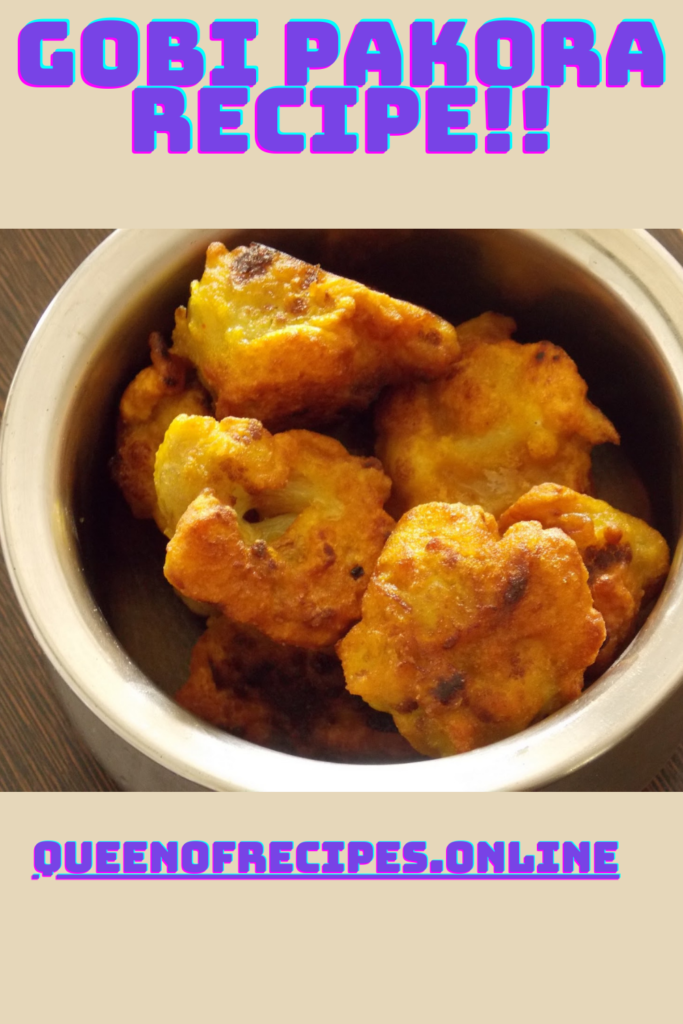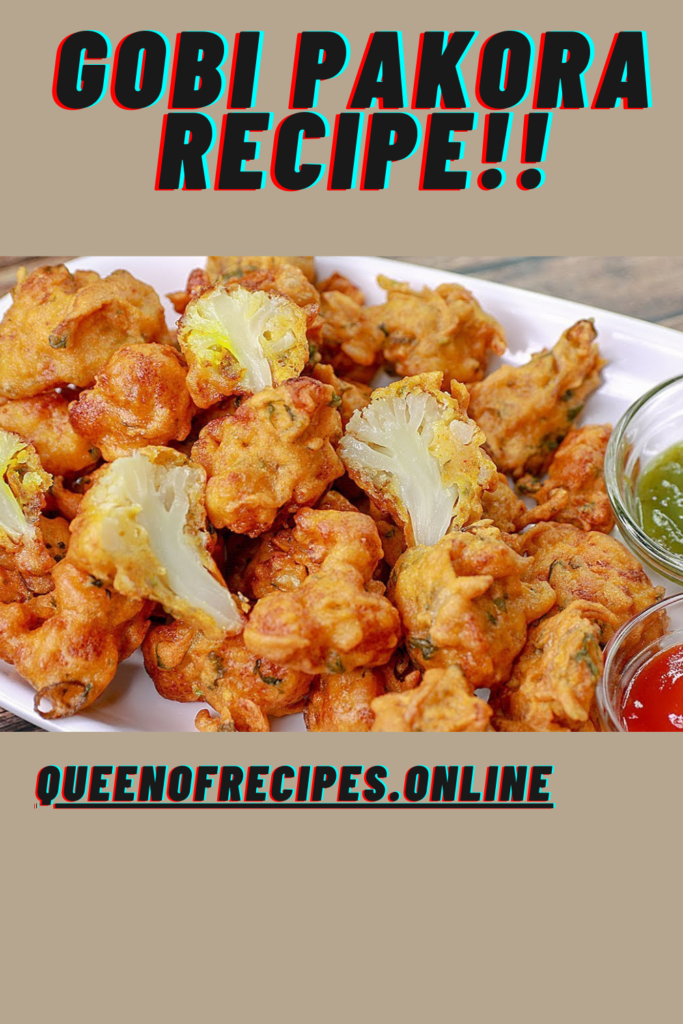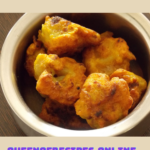Table of Contents
About Gobi Pakora.
Gobi Pakora, also known as cauliflower fritters, is a popular Indian snack enjoyed for its crispy texture and flavorful taste. In this dish, cauliflower florets are coated in a spiced chickpea flour batter and deep fried until golden brown. Gobi Pakoras are often seasoned with a blend of aromatic spices like cumin, coriander, and turmeric, which infuse the cauliflower with delicious flavor. This savory snack is perfect for tea-time gatherings, parties, or as an appetizer. With its crunchy exterior and tender cauliflower inside, Gobi Pakora is a delightful treat that is sure to please your taste buds.
Here’s a simple recipe to make Gobi Pakora:
Ingredients for making Gobi Pakora:
- 1 small cauliflower head, cut into small florets
- 1 cup chickpea flour (besan)
- 2-3 tablespoons rice flour (optional, for extra crispiness)
- 1 teaspoon cumin seeds
- 1 teaspoon coriander powder
- 1/2 teaspoon turmeric powder
- 1/2 teaspoon red chili powder (adjust to taste)
- Salt to taste
- Water, as needed
- Oil for deep frying
- Fresh coriander leaves, chopped (optional, for garnish)
Instructions for making Gobi Pakora:
- In a mixing bowl, combine chickpea flour, rice flour (if using), cumin seeds, coriander powder, turmeric powder, red chili powder, and salt. Mix well to combine all the dry ingredients.
- Gradually add water to the dry ingredients, whisking continuously, until you get a smooth and thick batter. The consistency should be thick enough to coat the cauliflower florets well. Set the batter aside.
- Heat oil for deep frying in a deep pan or kadhai over medium-high heat.
- While the oil is heating, wash the cauliflower florets and pat them dry with a kitchen towel.
- Once the oil is hot, dip each cauliflower floret into the batter, ensuring it’s evenly coated.
- Carefully drop the coated cauliflower florets into the hot oil, one by one. Do not overcrowd the pan.
- Fry the pakoras in batches, turning occasionally, until they turn golden brown and crispy. This usually takes about 4-5 minutes per batch.
- Once the pakoras are done, remove them from the oil using a slotted spoon and transfer them to a plate lined with paper towels to drain off excess oil.
- Repeat the process with the remaining cauliflower florets and batter.
- Serve the hot and crispy Gobi Pakoras immediately with mint chutney, tamarind sauce, or your favorite dipping sauce. Garnish with chopped coriander leaves if desired.
Enjoy your homemade Gobi Pakoras as a delicious snack or appetizer!
How to make Healthier Version of Gobi Pakora.
To make a healthier version of Gobi Pakora, you can try baking or air frying them instead of deep frying. Here’s a recipe:
Ingredients for making Gobi Pakora:
- 1 small cauliflower head, cut into small florets
- 1 cup chickpea flour (besan)
- 2-3 tablespoons rice flour (optional, for extra crispiness)
- 1 teaspoon cumin seeds
- 1 teaspoon coriander powder
- 1/2 teaspoon turmeric powder
- 1/2 teaspoon red chili powder (adjust to taste)
- Salt to taste
- Water, as needed
- Cooking spray or oil for brushing
Instructions for making Gobi Pakora:
- Preheat your oven to 200°C (400°F).
- In a mixing bowl, combine chickpea flour, rice flour (if using), cumin seeds, coriander powder, turmeric powder, red chili powder, and salt. Mix well to combine all the dry ingredients.
- Gradually add water to the dry ingredients, whisking continuously, until you get a smooth and thick batter. The consistency should be thick enough to coat the cauliflower florets well. Set the batter aside.
- Line a baking sheet with parchment paper or lightly grease it with cooking spray.
- Dip each cauliflower floret into the batter, ensuring it’s evenly coated, and place them on the prepared baking sheet in a single layer.
- Once all the cauliflower florets are coated and arranged on the baking sheet, lightly spray or brush them with cooking spray or oil. This will help them crisp up in the oven.
- Bake it in the preheated oven for 20-25 minutes, flipping them halfway through, until they are golden brown and crispy.
- Once done, remove the baked Gobi Pakoras from the oven and let them cool slightly before serving.
- Serve the healthier Gobi Pakoras hot with mint chutney, tamarind sauce, or your favorite dipping sauce.
Enjoy your guilt-free Gobi Pakoras made with a healthier cooking method!


Nutritional value for Gobi Pakora.
The nutritional value of it can vary based on factors such as the size of the serving, the ingredients used, and the cooking method. Here’s a general approximation of the nutritional content per serving (approximately 100 grams) of traditional deep-fried Gobi Pakora:
- Calories: Around 200-250 kcal
- Carbohydrates: Approximately 20-25 grams
- Protein: About 5-7 grams
- Fat: Around 10-15 grams
- Fiber: Approximately 3-5 grams
- Sodium: Varies based on salt content and additional seasoning
It’s important to note that these values are approximate and can vary depending on the specific recipe and cooking method used. Additionally, the nutritional content may change if you opt for a healthier preparation method such as baking or air frying instead of deep frying. If you’re looking for a healthier option, you can modify the ingredients and cooking method accordingly to reduce the calorie and fat content while increasing the nutritional value.
Health Benefits of Gobi Pakora.
While Gobi Pakora is a delicious snack, it’s important to note that it is typically deep-fried and contains ingredients like cauliflower and chickpea flour. Here are some potential health benefits of it:
- Cauliflower: Cauliflower is a cruciferous vegetable rich in nutrients like vitamin C, vitamin K, and folate. It also contains antioxidants and fiber, which may help support digestive health and reduce the risk of chronic diseases.
- Chickpea Flour (Besan): Chickpea flour is a good source of plant-based protein, dietary fiber, and micronutrients like iron and magnesium. It provides sustained energy and may help regulate blood sugar levels.
- Spices: Many of the spices used in Gobi Pakora, such as cumin seeds, coriander powder, and turmeric, have potential health benefits. For example, turmeric contains curcumin, a compound known for its anti-inflammatory and antioxidant properties.
- Moderation: Enjoying it in moderation as part of a balanced diet can contribute to overall enjoyment and satisfaction with food. While it’s not a health food, occasional indulgence can be a part of a healthy lifestyle.
However, it’s worth noting that deep-fried foods like Gobi Pakora are high in calories, fat, and sodium. Therefore, it’s best to consume them in moderation and consider healthier cooking methods such as baking or air frying to reduce their calorie and fat content. Additionally, pairing Gobi Pakora with healthier accompaniments like fresh salads or vegetable-based dips can help balance out the meal.
Tips and Tricks for making Gobi Pakora.
Here are some tips and tricks to make delicious Gobi Pakoras:
- Select Fresh Cauliflower: Choose a small cauliflower head with tightly packed florets and no signs of discoloration or wilting for the best flavor and texture.
- Pre-Soak Cauliflower: Soaking the cauliflower florets in salted water for about 15-20 minutes helps remove any dirt or insects hidden in the crevices and ensures they are clean before cooking.
- Slice Cauliflower Uniformly: Cut the cauliflower florets into uniform-sized pieces to ensure even cooking and consistent texture in the pakoras.
- Dry Cauliflower Thoroughly: After soaking, drain the cauliflower florets and pat them dry with a kitchen towel to remove excess moisture. This helps the batter adhere better and results in crispier pakoras.
- Season the Batter Well: Add a generous amount of spices like cumin seeds, coriander powder, turmeric, and red chili powder to the batter for flavor-packed pakoras.
- Adjust Batter Consistency: The batter should be thick enough to coat the cauliflower florets evenly but not too thick. Add water gradually while preparing the batter to achieve the desired consistency.
- Fry in Batches: Fry the pakoras in small batches to prevent overcrowding the pan, which can lead to uneven cooking and soggy pakoras. Ensure the oil is hot enough before adding each batch.
- Maintain Oil Temperature: Keep the oil temperature consistent throughout the frying process. Fry the pakoras on medium heat to ensure they cook through without burning.
- Drain Excess Oil: Once the pakoras are golden brown and crispy, remove them from the oil using a slotted spoon and transfer them to a plate lined with paper towels to drain off excess oil.
- Serve Hot: Enjoy it immediately while they are hot and crispy for the best taste and texture. Serve with your favorite chutney or dipping sauce for extra flavor.
By following these tips and tricks, you can make flavorful and crispy Gobi Pakoras that are sure to impress your friends and family!


Serving Suggestions for Gobi Pakora.
Here are some serving suggestions for Gobi Pakora:
- Chutneys: Serve Gobi Pakoras with a variety of chutneys such as mint chutney, tamarind chutney, or coriander chutney. These flavorful dips complement the crispy pakoras perfectly.
- Sauces: Pair it with tangy sauces like tomato ketchup, chili sauce, or yogurt-based dips. These sauces add a delicious contrast to the spicy and crispy pakoras.
- Salad: Serve Gobi Pakoras with a side of fresh salad made with cucumber, tomatoes, onions, and lemon juice. The freshness of the salad balances out the richness of the pakoras.
- Raita: Enjoy Gobi Pakoras with a refreshing side of raita, which is a yogurt-based condiment flavored with spices like cumin, mint, and coriander. The creamy texture of raita complements the crunchy pakoras.
- Sandwiches or Wraps: Use Gobi Pakoras as a filling for sandwiches or wraps along with some sliced onions, tomatoes, and chutneys. This makes for a delicious and satisfying meal.
- Chaats: Transform Gobi Pakoras into a delightful chaat by topping them with chopped onions, tomatoes, green chilies, yogurt, tamarind chutney, and chaat masala. This savory snack is bursting with flavors and textures.
- Teatime: Enjoy it as a tea-time snack with a hot cup of masala chai or your favorite beverage. The spicy and crispy pakoras pair perfectly with the warmth of the tea.
- Indian Thali: Include Gobi Pakoras as part of an Indian thali (platter) along with other dishes like dal, sabzi, rice, and roti. This creates a balanced and satisfying meal with a variety of flavors and textures.
These serving suggestions enhance the experience of enjoying it and make them suitable for different occasions and preferences. Feel free to mix and match these ideas to create your own unique combinations!
FAQs for Gobi Pakora.
How can I make Gobi Pakoras gluten-free?


To make gluten-free Gobi Pakoras, you’ll need to ensure that all ingredients used in the batter are free from gluten. Use chickpea flour (besan) as the main flour, as it is naturally gluten-free. Avoid adding any flours or ingredients that contain gluten. Additionally, be cautious of cross-contamination by using separate utensils, bowls, and cooking surfaces that haven’t come into contact with gluten-containing ingredients. By using gluten-free chickpea flour and being mindful of cross-contamination, you can enjoy delicious gluten-free Gobi Pakoras without compromising on taste or texture.
How do I store leftover Gobi Pakoras?



To store leftover Gobi Pakoras, allow them to cool completely at room temperature. Then, transfer them to an airtight container or a zip-top bag and store them in the refrigerator for up to 2-3 days. To maintain their crispiness, place a paper towel at the bottom of the container to absorb any excess moisture. Reheat them in a preheated oven or toaster oven until heated through before serving. Avoid storing them in the refrigerator for too long, as they may lose their crispiness over time.
How do I ensure that the Gobi Pakoras are crispy?


To ensure that the Gobi Pakoras are crispy, follow these tips:
Hot Oil: Make sure the oil is hot enough before frying the pakoras. Test it by dropping a small amount of batter into the oil; it should sizzle and float to the top immediately.
Batter Consistency: Ensure that the batter is neither too thick nor too thin. It should coat the cauliflower florets evenly but not form a thick layer.
Fry in Batches: Fry the pakoras in small batches, making sure not to overcrowd the pan. Overcrowding can cause the temperature of the oil to drop, resulting in soggy pakoras.
Even Coating: Dip each cauliflower floret into the batter, ensuring it’s evenly coated. This helps create a uniform crispy layer when fried.
Consistent Heat: Maintain a consistent medium-high heat while frying. Fluctuating temperatures can lead to uneven cooking and soggy pakoras.
Drain Excess Oil: After frying, remove the pakoras from the oil using a slotted spoon and transfer them to a plate lined with paper towels to drain off excess oil. This prevents them from becoming greasy.
Following these tips will help you achieve perfectly crispy Gobi Pakoras that are golden brown and delicious.
How do I prevent the batter from becoming too thick or thin?



To prevent the batter from becoming too thick or too thin, follow these guidelines:
Gradually Add Water: While preparing the batter, add water gradually to the chickpea flour (besan) mixture while whisking continuously. This allows you to control the consistency and prevents the batter from becoming too thin too quickly.
Consistency Check: Stop adding water once the batter reaches a smooth and thick consistency that coats the cauliflower florets well. The batter should be thick enough to adhere to the florets without dripping off too easily.
Adjust as Needed: If the batter becomes too thin, add a bit more chickpea flour to thicken it. Conversely, if it becomes too thick, gradually add small amounts of water until you reach the desired consistency.
Test with a Spoon: Before coating all the cauliflower florets, test the batter by dipping a spoon into it. The batter should lightly coat the back of the spoon without running off too quickly.
By following these tips and adjusting the ingredients as needed, you can achieve the perfect consistency for your Gobi Pakora batter, resulting in deliciously crispy pakoras.

